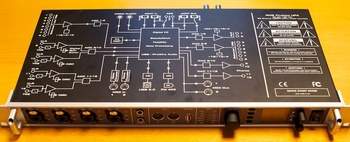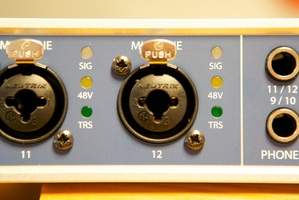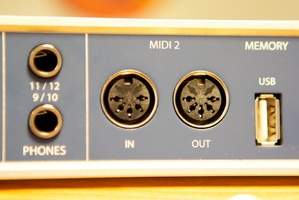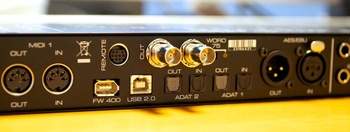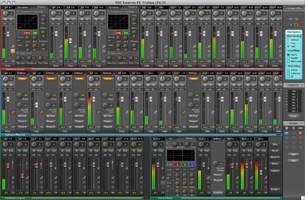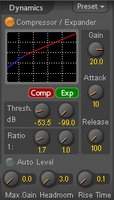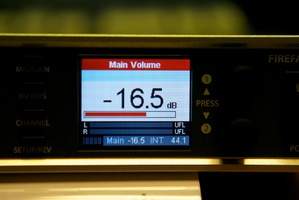Six years after the FireFace 800, RME hits the external audio interface market again with a new flagship product: the FireFace UFX, which doesn't really replace its big brother — it outright and blatantly outclasses it. Focus on what could be the ultimate interface.
We have been waiting a long time for a new product that would replace the famous FireFace 800 — a best-seller and a standard among digital audio interfaces. We were surprised to discover a new FireFace that isn’t meant to replace the 800 but to extend the top range of RME products. Yes, the UFX beats the old good FireFace 800 in every respect, but it is also much more expensive. So, what’s new? Let’s have a closer look…
The interface won’t look that unfamiliar when you unpack it: the FireFace UFX is a 1U rack with exactly the same dimensions as the FireFace 800. It has the classic RME look: blue, gray and metal. It looks serious but we’ve seen sexier things! However, there is no doubt that this is a FireFace…
However, taking a closer look you will notice that the interface is very different from its big brother — both at the software and hardware levels. Let’s start with the hardware.
Nice Looks, Nice Display
The front panel is equipped with four Neutrik combo connectors for XLR and 1/4" jacks. You can feed the inputs with a mic, line or instrument (guitar, bass, etc.) signal. Each of the four analog inputs has three LEDs to indicate when a signal is present, the 48-V phantom power for condenser mics is on and the 1/4" jack is selected. We’ll explain further on how to use these features.
On the right hand, you’ll find the two fully independent, in terms of volume settings and source selection, headphone outputs (9/10 and 11/12). In other words, each headphone gets its own mix.
You’ll also find standard MIDI ins/outs in the form of 5-pin DIN connectors, plus a mysterious host type USB port. A quick look in the documentation revealed that this port has currently no function, but the manufacturer promises that it will allow the user to connect a USB key or a hard drive in the future (with a firmware upgrade?). The FireFace UFX will then become a standalone direct-to-disk recording system giving you the possibility to record and read audio files directly from the USB storage device. Nice! The manufacturer promises to free you completely from your computer, which will surely appeal to nomad sound engineers. To be followed very closely!
In the middle of the front panel, a 10-segment LED bar allows the user to monitor the sync (WordClock, AES or ADAT), the MIDI transfer and the status of the USB and FireWire connections. Yes, you read that right: the interface offers USB and FireWire operation — a milestone in RME history.
Let’s close this front panel overview with the most important thing: the brand new multifunction color display which has a pretty good definition. Besides the VU-meters for all (analog and digital) inputs, it also gives you access to all channel parameters, mic in level settings, headphones and master out level settings, the interface’s setup, and even internal FX settings (reverb, echo, etc.). The three rotary encoders and the four buttons next to the display allow you to easily browse the menus and access almost all parameters without having to look at your computer screen. This looks very promising when you think about the future USB direct-to-disc facility…
Since images are worth a thousands words, here is a short video from RME to show you how the display works:
The display’s resolution makes it possible to show lots of information and it makes browsing easy. We just regret that there is only one control to set the level of the main out and the two headphones outputs. Separate controls for the phones outs would have been better, especially when a mistake could lead to very loud signals in the headphones and you wanted to lower the volume quickly…
No cons otherwise. Hats off RME!
Now, let’s take a look at the rear connections…
Rear Panel
Besides the four analog inputs on the front, the FireFace UFX provides eight additional analog inputs on 1/4" TRS jacks on the rear panel. You also get eight analog outputs including six 1/4" TRS jacks plus two XLR connectors (main outs 1&2). The digital interface is very comprehensive: XLR AES/EBU in/out and two pairs of TOSLINK ADAT ins/outs. The second ADAT connector can be used for S/PDIF connections. Keep in mind that the number of channels depends on the sampling rate selected: for ADAT connections, you get sixteen ins/outs at 44.1/48 kHz, eight ins/outs at 88.2/96 kHz and only two at 176.4/192 kHz. Finally, the FireFace UFX can manage up to 60 channels at 44.1/48 kHz (30 inputs and 30 outputs: twelve analog, two AES/EBU, and sixteen ADAT). It’s more than the FireFace 800 and its 56 channels.
The device also provides two BNC connectors for the word clock and a multipin connector for the optional remote control. We had no opportunity to try the remote control, which appears to be very simple (store, recall, volume). The FireFace can also be controlled via MIDI and supports the Mackie Control protocol. This allows you to control the faders of the virtual mixer, activate the TalkBack, set the pan, use the mute and solo functions, load snapshots, etc. That’s why you also get a second MIDI in/out interface on the rear panel!
Let’s close this paragraph with the USB and FireWire connectors: the user can choose (or not if he has no FireWire) one of the two options to connect the FireFace UFX to his computer. If both are connected, priority is given to the USB port. Further on we’ll show you the different results the USB and FireWire ports gave with our computer…
But let’s talk first about the software provided!
TotalMix FX
Besides the presence of two different drivers (USB and FireWire), one of the main new features is the newest version of the TotalMix software, a virtual mixer that allows you to mix and manage all 60 channels of the RME interface. This time around the software has the FX suffix, which refers to the integrated effects we will describe a bit later. Compared to the new GUI, the previous one seems like a relic — RME seems to have left austerity behind… This small piece of software looks pretty much like a virtual mixing console: the hardware inputs are on top, the software returns (your sequencer in most cases) in the middle and the hardware outputs at the bottom, along with the control room section.
Let’s make it clear right now: TotalMix is almost perfect and the routing possibilities it provides are almost endless. Since the FireFace includes 30 output channels, you’ll have the ability to manage up to 15 stereo sub-mixes and route them to any hardware output (line, phones, digital…) and even to route a single signal to several outputs. The multi-client ASIO driver allows you to use it with several programs at the same time.
Each input can be linked in stereo with the next or previous one, and you can switch on the phantom power and the instrument input directly from the channel. The gain stage of the preamps is digitally controlled. And there are also other settings available: stereo width (for stereo sources), send to internal effects (reverb and echo), MS operation (for input in stereo mode), and phase reverse. You also get standard Mute and Solo switches. Especially noteworthy is the addition of two new processors to all channels (except the software returns): a 3-band parametric EQ with low-cut and preset manager, plus a dynamics processing unit including compressor, expander and an auto level setting. Parameters and processing are pretty standard so you’ll feel at home right away. Finally, a gain trim is provided to sync the channel volume in all sub-mixes.
You can also adjust the effect returns (reverb and echo), manage the level (+4dU, –10dBV…), the EQ, the dynamic processing, and the phase reverse. Plus, you can also activate a Loopback function, which can become very useful, since it allows you to record sub-mixes: the channel sum, the effects, etc. Very nice!
In the control room section, you can assign the main out to any hardware output. The same applies to all four headphones outputs. The main out includes a DIM function (momentary level attenuation of the overall volume), a Mono switch to check mono compatibility and phase problems, a TalkBack switch to communicate with the musicians, and a Mute FX switch that mutes the reverb and echo effects.
On the right hand side there are different parameters and display functions: for example, if the workspace seems too small you have the possibility to make it a two-channel display instead of the default three-channel one, you will also be able to switch the channel meters to be pre/post effects, activate the gain trims for all channels, select between Peak and RMS level display, etc. You’ll also find here the main Mute and Solo switches as well as a temporary fader group. Also notice that you have unlimited undos/redos. Well done!
Both Aux FX appear once you click the “FX” button. There is a reverb section with four different room algorithms with adjustable, gated, standard, and long envelopes. It has different parameters available, depending on the algorithm selected: PreDelay, Low Cut, High Cut, Room Scale, Smooth, Width, Volume… The echo effect has three different algorithms: Stereo Echo, Stere Cross (for stereo sources) and Pong Echo (the classic ping-pong effect). Everything is very comprehensive, RME takes things very seriously!
Finally, on the lower right corner of the interface you’ll find the mute, solo and fader groups. They are very simple and easy to use, just like the snapshots that allow you to store and recall up to eight virtual mixer settings.
In Use
To review the interface, we used a 24" iMac with 2.4 GHz Intel Core 2 Duo CPU and 4 GB of RAM. We used the interface via USB and via FireWire and noticed a slight difference regarding latency (with Cubase): with the minimum buffer size (32 samples!), the USB interface has an input latency of 1.769 ms while the FireWire interface has 1.837 ms input latency. The difference is insignificant. On the other hand, the difference in CPU load is more noticeable.
With our test system, the kernel task uses up about 10% of the CPU when the FireFace is connected via USB, but it reaches almost 35% with the FireWire connection. Certainly every computer will have a different behavior and this can not be taken as a general rule. However, it’s interesting to note that our iMac has a better performance regarding latency and CPU load with the USB connection. This difference will certainly change with firmware and driver updates.
When it comes to sound quality, we connected a low output Oktava MK-012–01 mic. We placed it in front of the 12th fret of our Gibson J-200 acoustic guitar and we were surprised by the FireFace’s gain headroom. In fact, turning the gain control a bit pass the center position we reached peaks at –3dB, which is quite good for the internal preamp of a digital audio interface. The preamp provides up to 65 dB of gain making it very easy to use with a wide range of sound sources. Based on the same technology as the famous RME Micstasy (even though they are not quite the same; nice dream!), these preamps are very convincing: transparent sound without noise and distortion. The gain’s digital control is very convenient and it allows you to easily recall your settings.
Working by pairs (you get two parallel converters for each input), the AD converters are also remarkable and they have a very good signal-to-noise ratio. Spec sheet freaks will find all specs here.
The internal processing, i.e. EQ, compressor and reverb sound very good too. We recorded a dry guitar first so you can make up your own opinion, and we then switched on the auto level, the compressor and the EQ one by one. In the third sound sample, we also added the internal reverb effect.

- RME UFX Guitar Dry00:40
- RME UFX Guitar Dry – Auto Level – Comp – EQ00:46
- RME UFX Guitar Reverb00:46
The computer never crashed during the review, but we did notice some unwanted noise when latency time was set to the minimum (32 samples!) and we added too many virtual instruments and VST effects. This is due to the limited power of the computer. In short, considering the fact that the interface is brand new, it provided very good results with our old computer.
Conclusion
RME decided to bring out the full artillery with its new digital audio USB and FireWire interface. The UFX is so comprehensive that it’s difficult to find drawbacks: very comprehensive connections, up to 60 channels, color display with good definition, USB and FireWire support, almost perfect TotalMix FX software, insert effects (compressor, EQ…), send effects (reverb, echo) and an upcoming function that will allow you to record and play audio data directly on and from a USB key or hard drive! The audio quality is guaranteed with the high-class preamps and converters. On the other hand, we miss dedicated controls to adjust the headphones volume, a more comprehensive remote control, and a more friendly price. Anyway, the new reference has arrived and its name is FireFace UFX.

